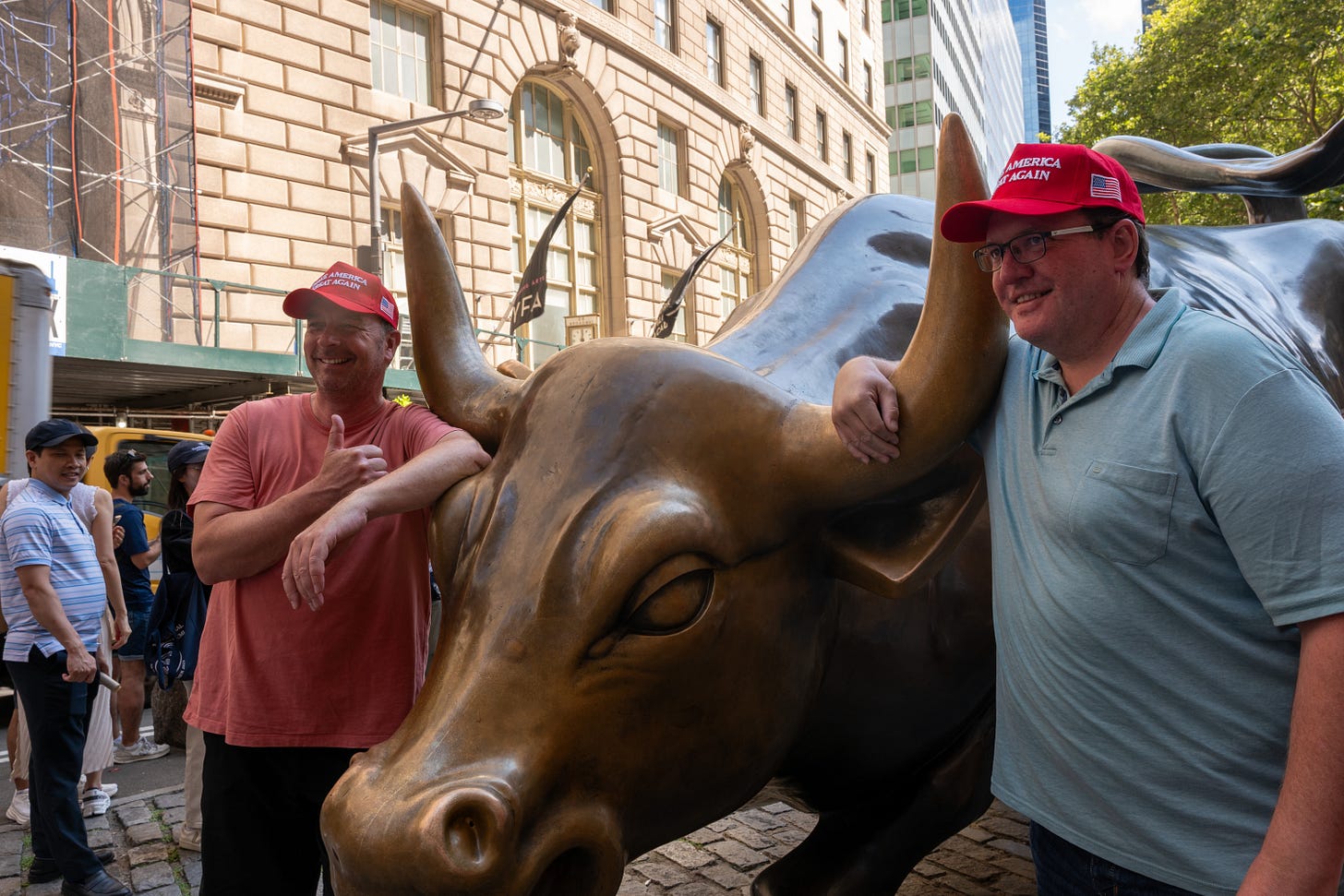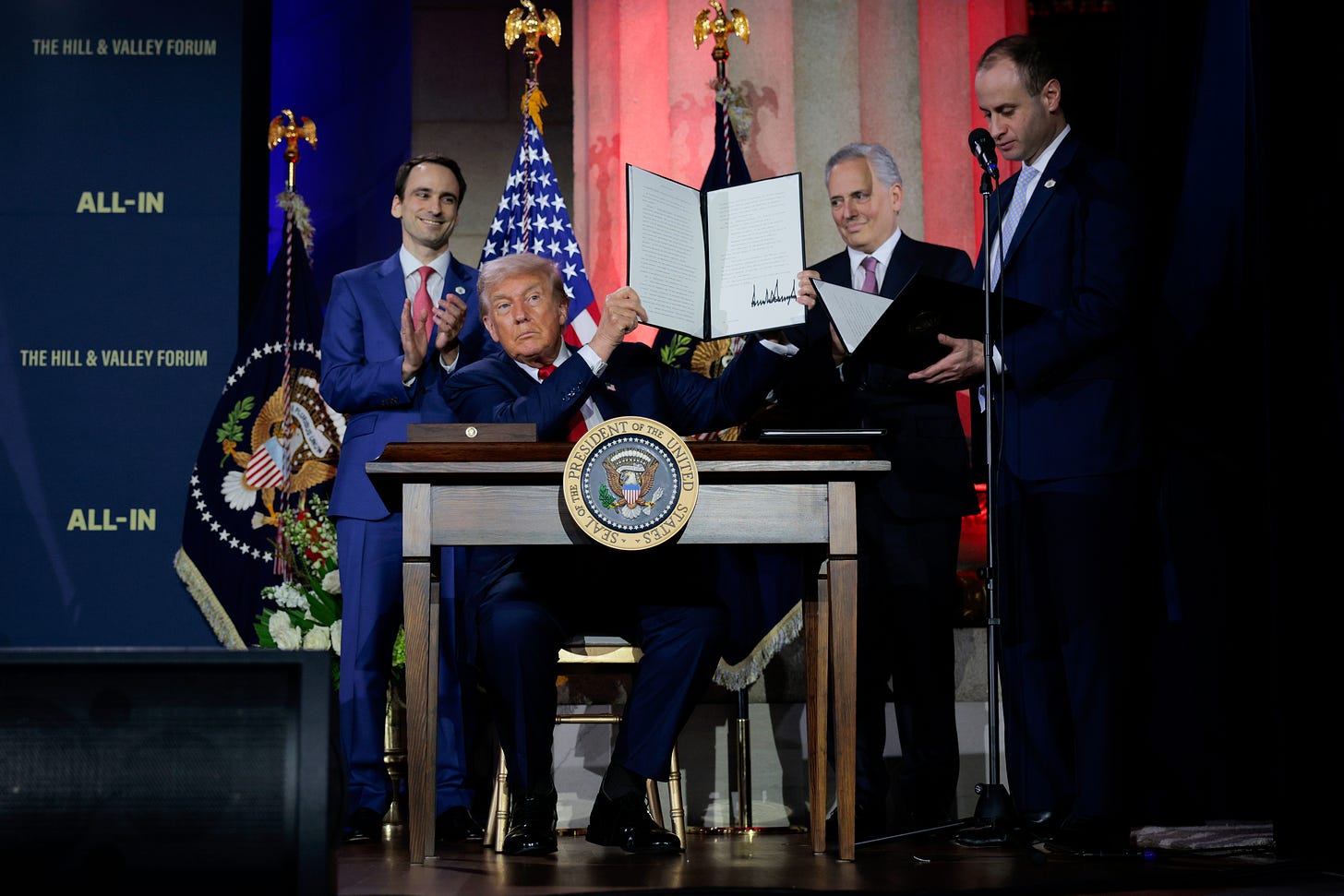Deregulatory Bonanza Fuels the Private Markets. Caveat Emptor.
Plus, Trump's 'AI Action Plan' leans into the culture wars
The Week in Short
As companies have delayed and avoided IPOs, investment has flowed to the more loosely regulated private markets. Soon, 401(k) plans could join the party. President Trump thrilled his Silicon Valley supporters with a new AI Action Plan, and signed three new executive orders on AI.
Behind the Paywall: Tesla shares dropped on rough earnings while Google picked up praise for its performance. Meme stocks are now ChatGPT-powered. Armada, Xelix, and Reka AI fill their warchests. Plus, Benchmark’s Victor Lazarte is leaving to raise his own fund.
The Main Item
PE & VC Funds Could Get a Lift from Small Investors. They Need to Make it a Win-Win.
As deregulation fever sweeps the financial sector, private markets of every kind could see an influx of retail investors looking for somewhere to put their money — and that could provide a nice lift to the Silicon Valley ecosystem.
It also means a new era of caveat emptor.
The bright line between heavily policed public markets and so-called “alternative assets” including private company shares, private-equity and venture funds, and crypto-currencies is blurring fast. Private credit is moving in on banking. Sports-betting and day-trading are moving into the same apps.
The logic in giving a broader swath of investors access to private markets is simple enough: that’s where the action is. With VC and PE firms willing to provide all the capital a growth company needs, the burdens of public-market regulation and the comparative lack of appetite for IPOs is keeping big, hot companies like OpenAI private indefinitely.
Many investors are eager to get a piece of private juggernauts like OpenAI and SpaceX, and there are many more strong startups coming up behind them as the AI boom roars. Meanwhile there are only half as many public companies in the U.S. as there were back in the late 1990s.
Even the recent string of IPOs hardly compares to the boom times of 2021, PitchBook data shows, with most of the value still in the private markets.
It seems like an obvious win-win to bring a larger pool of investors into private-market wealth creation.
A few big mutual fund purveyors like Fidelity took a step in that direction when they began to make late-stage VC investments more than a decade ago.
Coatue in May showed a much more concentrated version of what that can look like: a new fund aimed at wealthy individuals that invests in high-growth companies both public and private, with Jeff Bezos and Michael Dell seeding the fund to the tune of $1 billion. The minimum investment is $50,000, much less than what would have once been required for access to the best private companies.
An even more dramatic move could be set in motion with an anticipated executive order from President Trump that would begin clearing the way for 401K plans, the retirement instruments that currently hold some $12.4 trillion, to invest in alternative assets. That follows the Dept. of Labor’s move last month to ease restrictions on holding crypto assets in 401K funds.
Major fund managers including Apollo and State Street are already setting up partnerships with 401K managers, though fiduciaries of those plans may take some persuading on what kinds of risks are acceptable, and legal reforms may be needed too.
With freer money flows come greater responsibilities. History has shown that there are many good reasons for financial market regulation. One big one is that private markets can be anything but a level playing field, and investors who are less powerful and sophisticated than the big institutions can easily get the short end.
The fees associated with getting access to private shares, for example, can be a huge overhang. An expensive special-purpose vehicle set up to buy shares in an OpenAI or SpaceX might then syndicate those holdings to funds catering to smaller investors — creating two layers of significant fee extraction between the investor and the company.
The companies, in turn, have minimal disclosure requirements, so it’s hard to ferret out risk or spot bad actors. The big investors get financial reports, but it’s unlikely that small investors who end up with shareholdings through hedge funds or SPVs will see anything like that, or have any visibility into governance.
When it comes to 401Ks, there’s also the risk that retirees will be drawn to relatively risky and high-fee options that don’t serve them well. It’s not a coincidence that private equity and VC firms are pushing hard for new sources of capital at a moment when a broad swath of firms are struggling to return cash to their LPs, and therefore struggling to attract new funds.
That’s why there’s a disconnect between industry enthusiasm for bringing in smaller investors and a skeptical financial commentariat. Bitcoin as a retirement holding is being panned. Jason Zweig at the Wall Street Journal has a laundry list of reasons why alternative assets don’t belong in 401Ks.
There’s certainly a compelling case that small investors should have the opportunity to share in private market gains, and that they can assess risks for themselves. Now it will be up to the industry to show that much looser rules can truly enable more people to profit from the tech bonanza without opening the door to fraud and rent-seeking. It won’t be easy.
Politics & Policy
Trump’s AI Plan Welcomed by Founders & Investors Amid Attacks on ‘Woke AI’
Silicon Valley’s AI accelerationists ran a victory lap in Washington DC this week as the Trump Administration unveiled an “AI Action Plan” that throws caution to the wind in pursuit of American dominance.
The 23-page plan, developed by AI and Crypto Czar David Sacks and the Office of Science and Technology Policy, reads in large part like an industry wish-list. It rolls back safety initiatives, seeks to prevent states from adopting their own regulations, strips environmental regulations from data center projects, and green-lights AI chip sales to China. Bloomberg called it “a gift to Silicon Valley.”
Ominously, though, the plan also dictates that AI makers must “eliminate references to misinformation, Diversity, Equity, and Inclusion, and climate change,” and more generally “must be free from ideological bias and be designed to pursue objective truth.”
That’s code for requiring generative AI outputs to favor MAGA ideology, making it the latest in President Trump’s long string of plainly unconstitutional diktats. There’s been little public industry pushback, at least so far.
Trump signed three AI-focused executive orders at a Hill & Valley event Wednesday to kick off some aspects of the plan — one to fast-track data centers, another to promote American AI abroad, and the third barring the government from working with AIs that surface unapproved political views.
The most immediate effect of Trump’s approach is to enshrine the right of Nvidia, as well as AMD and others, to sell advanced chips to China after being blocked earlier this year. That’s controversial, but certainly a boon to the companies, and a testament to Nvidia CEO Jensen Huang’s persuasiveness and new-found fealty to Trump.
Huang lauded the President on stage, saying that “America's unique advantage that no country could possibly have is President Trump” when it comes to AI dominance.
The order seeking to govern the ideology of AI chatbots is unlikely to ever have the force of law, but as Kevin Roose points out, that isn’t necessarily the point. He compares it to the jawboning strategy Republicans employed to pressure social media companies on content moderation, which ultimately succeeded in spectacular fashion. Mark Zuckerberg was happy to roll back fact-checking voluntarily, to cite only the most prominent example.
Concerns about free speech were not high on anyone’s agenda Wednesday though: it was a chummy vibe among the AI leaders present and tech’s deregulatory allies in the administration, including Secretary of the Interior Doug Bergum and Vice President JD Vance.
Vance, interestingly, championed the public-private partnerships that built the military-industrial complex of the mid-20th century while repeatedly criticizing the Biden administration’s more cautious attitude towards AI regulation. The plan calls for “streamlining” regulations relating to data centers, chip fabs, and energy development.
A few more takeaways:
Trump kept red-meat politics front and center during his keynote, jumping from the AI conversation to an extended rant about “men in women’s sports” and jabs at New York mayoral primary winner Zohran Mamdani.
Frontier tech and AI founders who attended the event were extremely optimistic about the AI action plan. Two told us on background that the biggest issues to them were the Biden-era LLM safety rules, which they felt were too onerous for startups. General Catalyst’s Teresa Carlson told us she hopes Congress will make it all “lasting federal policy,” though no legislation is currently on tap.
The Action Plan calls for big investments in AI science, data and evaluation systems, and workforce development, though it’s unclear how much money might ultimately support those initiatives. It also presses for quick diffusion of AI in government and especially the military.
Newcomer Podcast
Trump's Plan to Win the AI Race
Eric, Tom, and Madeline get into the weeds of President Trump’s AI Action Plan. Tom lays out his defense of the AI labs in their ongoing copyright disputes with publishers.






